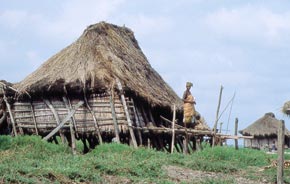
Pile dwelling in Ganvie, Benin, West Africa
Inhabited pile dwellings are still existent today in all parts of the world. For example, people still live in pile dwellings in Southeast Asia, West Africa or Central America.
Even in Europe, those houses on stilts can still be found in some places. In our latitudes they are however only used for bathhouses on beaches and vacation houses. These kinds of dwellings, one-story houses without a ground floor or basement are customary wherever floods invade people’s lives. This may be in river valleys, at lakes or near the ocean, where „dwellings on stilts“ were always considered effective protective measures. Nevertheless, in some places pile dwellings are often build to maintain building traditions or to guard against rodents or other crawling pests.
There are many kinds of techniques to construct a floor above the ground.
Great differences can also be noted between the various forms of the houses and the building constructions. Almost none of the floor, wall or roof plans are exactly alike. The forms of the houses and the technical solutions depend on the available building materials, the ideas, the value conceived by the builder, and most importantly the environmental conditions.
Logically, when building on a muddy lake bottom, the reinforcement of the foundation has to be planned more carefully than when building on clay soil. It is also logical that in areas where there is an abundance of straight growing confer wood, such as pine, the log cabin structures were a preferred building style, whereas in areas with a large deciduous tree standing, we will find timber framing with forked poles that supported the structure.
Since it has been established that during the stone and bronze age mixed deciduous forest dominated at Lake Constance, and the water level of the lake changed constantly, it is understandable that the prehistoric pile dwellings built with deciduous woods at the shores of Lake Constance, were the most common house type.